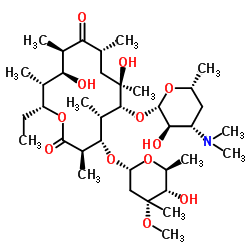Acid-catalyzed degradation of clarithromycin and erythromycin B: a comparative study using NMR spectroscopy.
M N Mordi, M D Pelta, V Boote, G A Morris, J Barber
Index: J. Med. Chem. 43(3) , 467-74, (2000)
Full Text: HTML
Abstract
One of the major drawbacks in the use of the antibiotic erythromycin A is its extreme acid sensitivity, leading to degradation in the stomach following oral administration. The modern derivative clarithromycin degrades by a different mechanism and much more slowly. We have studied the pathway and kinetics of the acid-catalyzed degradation of clarithromycin and of erythromycin B, a biosynthetic precursor of erythromycin A which also has good antibacterial activity, using (1)H NMR spectroscopy. Both drugs degrade by loss of the cladinose sugar ring and with similar rates of reaction. These results suggest that erythromycin B has potential as an independent therapeutic entity, with superior acid stability compared with erythromycin A and with the advantage over clarithromycin of being a natural product.
Related Compounds
| Structure | Name/CAS No. | Molecular Formula | Articles |
|---|---|---|---|
 |
berythromycin
CAS:527-75-3 |
C37H67NO12 |
|
A simple and rapid confirmatory assay for analyzing antibiot...
2007-01-01 [Rapid Commun. Mass Spectrom. 21(2) , 237-46, (2007)] |
|
An abiotic strategy for the enantioselective synthesis of er...
2003-07-21 [Angew. Chem. Int. Ed. Engl. 42(28) , 3278-81, (2003)] |
|
Design, synthesis, and evaluation of stable and taste-free e...
2005-06-02 [J. Med. Chem. 48(11) , 3878-84, (2005)] |
|
An unexpected interaction between the modular polyketide syn...
2002-09-03 [Biochemistry 41(35) , 10827-33, (2002)] |
|
Chemical modification of erythromycins. IV. Synthesis and bi...
1990-05-01 [J. Antibiot. 43(5) , 544-9, (1990)] |